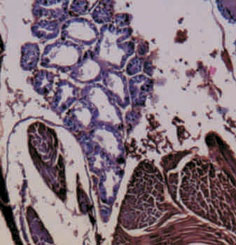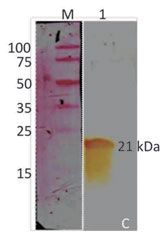
-
White-tail disease (WTD) is an acute viral disease of Macrobrachium rosenbergii affecting the post-larval and early juvenile stages causing up to 100% mortality resulting huge loss to farmers. The disease is caused by two RNA viruses, M. rosenbergii nodavirus (MrNV) and a satellite virus, extra small virus (XSV). The disease can be controlled by early detection of the virus in hatcheries and grow out ponds and eradication of the infected stock and segregating the healthy stock.

Fig 1. - The reaction of
monoclonal antibodies
against the recombinant
XSV capsid proteinDescription of technologyThe technology is based on detecting white tail disease affected M. rosenbergii post-larvae by immunodot assay using monoclonal antibodies. Monoclonal antibodies have been produced against the recombinant capsid protein of XSV. The monoclonal antibodies are specific to the XSV capsid protein and hence are used to detect the virus in infected samples. The test involves homogenization of the infected (suspected) postlarvae and blotting 2 μl of the clarified homogenate on a nitrocellulose membrane. The membrane is air-dried and blocked with blocking agents. The membrane is then incubated with the monoclonal antibodies for 1 hour. Subsequently the membrane is washed and incubated with anti-mouse HRP conjugate. The membrane is washed and incubated with substrate solution. Positive samples produce a brown precipitate.
Market potentialCurrently, the market potential of the technology is limited due to the fact that M. rosenbergii culture has come down markedly in recent times due to frequent disease outbreaks. However, there is a potential for this technology as WTD is the most pathogenic disease condition in M. rosenbergii in the early stages. The target users will be mostly scampi hatcheries and to a certain extent farmers of M. rosenbergii. Technology benefits Since the test involves homogenization, clarification and subsequent blotting on nitrocellulose membrane and detection by simple washing and incubation steps, the test does not require sophisticated equipment or skilled technician. The test can be performed at hatchery and farm level. The reagents can be packed in the form of a kit. Early detection of the disease will help in minimizing the loss to the hatchery and farmers by isolating the infected stock from the healthy ones.
